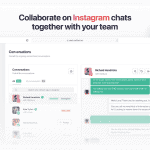Chatbots are considered the first impression that a company presents to its customers online, transmitting an appropriate and comfortable image. This is the importance of bots and their ability to establish interactions.
The uses attributed to them and the motivations may vary depending on the company’s objectives and the ways in which it wishes to act. Despite this. The tool in question has a single objective: to have a pleasant “natural”, effective conversation flow, capable of satisfying both parties.
First of all, people want to be heard, even when it comes to bots. While it is a potentially counterintuitive idea, hopefully users want humanized messages that make them feel at ease, which is an integral part of the customer service a business should always provide.
The fluidity of a conversation is given by the ability to receive and send messages quickly, concisely and comfortably with a flexible but always precise dialogue, capable of providing adequate and correct information. These are precisely the characteristics that chatbots must possess to convey fluidity during customer assistance.
When you decide to create a chatbot for your company, it is essential to ask yourself some key questions to create precise but impactful messages.
What do I want to communicate? It is important to clearly define the bot’s goals before sending automated messages.
How can I say this concisely? Customers are desperate for clarity and speed. That is why short, direct messages are the best option.
How can I put this in simple words? Eliminate complex or stilted sentences within your messages. Basic language will help customers understand everything without delay.
What options can I offer my customers? Not all users show the same doubts or problems. Therefore, you should offer several options in your messages to allow them to choose the best solution.
How can I best reflect the identity of my company? Even if it is not always so simple and immediate to convey sensations and emotions with automated messages, these must be consistent with the identity of your brand. At the same time, there is a need for familiarity so as to connect with customers.
Automated messages do not have to be robotic: give them a spark of humanity without ever losing sight of the end goal.
Artificial intelligence (AI) as an additional tool
You can also take advantage of AI features like machine learning through the use of customer behavior models along with natural language to offer even more accurate and precise experiences.
The conversation flow will be achieved as soon as the chatbot path is perfectly delineated. This means that the customer will have the opportunity to navigate between the different options in a natural way, always receiving effective and effective answers. Should the company require human attention, the agents will have sufficient information to do so.
Chatbot goals
You must always be clear about what you want to achieve with the chatbot and what type of interaction you want to have with customers. For example, assisting support agents or automating the processes of the services offered.
Know the customer
Being a business, you should not only know potential customers, but also analyze what kind of people could benefit from the chatbot in order to create the most suitable messages for them.
Personalization and humanization of the message
When building your chatbot, it is extremely helpful to focus on creating interactions that feel like you are talking to a human being.
An option capable of generating sympathy is to invent an imaginary character with very specific characteristics: gender, age, place, profession, etc. All of this will make it easier to implement features that can help you connect with customers, developing a persona they feel comfortable with.
Establish language and tone
Once you have created a customer profile, you also establish the chatbot’s way of conversing, choosing between simple, technical, jargon, etc. All this will strengthen the relationship and interaction between your company and the customer, always trying to establish a real connection, by using messages capable of encouraging and giving comfort to the customer.
Discover the most frequently asked questions
Customers will always have questions about your company and products. The chatbot can be a very useful tool, as it is capable of providing them with this basic information without the help of human agents, unless otherwise requested.
Effective messages
Customers should not have to guess messages when interacting with chatbots. We insist very much on the fact that automated messages must be simple, concise, clear and consistent with the company’s identity.
Create the conversational path
With the help of a team of marketing specialists, you will need to devise message paths and options for customers to navigate based on their needs and concerns. Set which choices will appear for each question asked, to make everything as simple as possible.
Check and correct
It is extremely important to give the option to talk to a human if the chatbot is not enough. In addition to detecting the most common questions for which customers want human attention, you will be able to establish the main and necessary paths for the final path, changing the automatic answers if necessary.
Every company has a different audience that it must adapt to. Therefore, using the same chatbot model is impossible. Here are four examples of chatbots depending on your business:
1) Service companies
The chatbot will have to replace customer service forms.
Begin the dialogue with an introduction to your fictional character, for example: “Hi, I’m Patricia. How can I help you?”
Create closed questions with options related to your services: “What service would you be interested in?” And among the different options, you could enter: “Service information, Maintenance, Consulting, etc.”
So, anticipate what you will ask the user: “Great, I need you to provide me with some information so an agent can contact you.” The chatbot may ask for your name, email and/or phone number.
End the interaction by letting the customer know that an agent will assist them soon and say goodbye: “Thank you very much, we have sent your information to an agent on our team who will contact you shortly. You can close this chat whenever you want. Thanks for choosing us”.
2) B2B (Business to Business) companies
In this case, the customers are other companies. The example seen previously can serve as a guide for designing your chatbot, but you will have to add or modify some questions to adapt it to the target audience.
The minimum information to consider will be: “What company are you contacting us from?” “Telephone number and contact extension” and “Company email”.
The last message can end similarly to the previous example.
3) E-commerce
If you own an e-commerce business, never underestimate your customers. The interaction goes far beyond the purchases made, which is why customer service is essential.
Because of the various scams present on the web, it is essential to create trust and loyalty with your customers. A chatbot is therefore essential to optimize the service offered at all times; especially with an audience accustomed to an easy and fast service.
Some dialogue options you could set are:
– I have a problem with my payment.
– I have a problem with my product.
– What payment methods do you have?
– What are the refund or return policies?
– I have doubts about my purchasing process.
– Do you have X units available?
– Are there any discounts (offers, bulk purchases, special days)?
4) Marketing agencies
If your company offers digital marketing services, the chatbot can be a tool in its own right, demonstrating the skills the company possesses. If you do good marketing in conversations, it means you can do it with other cases too. To explore potential collaborations or find additional resources for enhancing your digital marketing capabilities, consider finding marketing agencies on Sortlist.
It is advisable that the corporate image and the language used by the bot are always consistent. If the idea is to convey courageous and extroverted emotions, you can create dialogues with slang, memes, emojis, etc. On the contrary, if the objective is more serious and technical, the language must be more formal.
The basic idea is that there is always a demonstration of one’s skills, allowing the chatbot to stand out for its attention but, at the same time, to be consistent with the main objective of the brand and original in its characteristics and messages. The use of artificial intelligence in these cases can be an excellent example of innovation.

Creating chatbot flows suitable for your business is essential to increase the effectiveness and naturalness of the company. With Callbell you will have the possibility to create specialized flows, equipped with numerous features, actions and sections designed to customize the chatbot and increase your sales.
If you want to try the Callbell chatbot and create flows that convert everything effectively, click here.
About the author: Hello! I am Alan and I am the marketing manager at Callbell, the first communication platform designed to help sales and support teams to collaborate and communicate with customers through direct messaging applications such as WhatsApp, Messenger, Telegram and Instagram Direct




